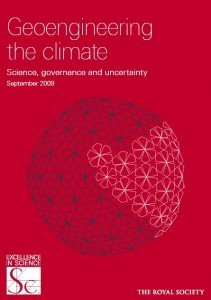A year-long Royal Society of London study looking at geoengineering techniques designed to combat climate change suggests such schemes could be a viable “plan B” if nations fail to reduce greenhouse gas emissions by more conventional means.
UPDATE: The AusSMC wraps up comment from Australian scientists on the geoengineering report.
 “It is an unpalatable truth that unless we can succeed in greatly reducing CO2 emissions we are headed for a very uncomfortable and challenging climate future, and geoengineering will be the only option left to limit further temperature increases,” said Professor John Shepherd, who chaired the Royal Society’s study Geoengineering the climate: science, governance and uncertainty.
“It is an unpalatable truth that unless we can succeed in greatly reducing CO2 emissions we are headed for a very uncomfortable and challenging climate future, and geoengineering will be the only option left to limit further temperature increases,” said Professor John Shepherd, who chaired the Royal Society’s study Geoengineering the climate: science, governance and uncertainty.
The Royal Society of New Zealand has produced a companion paper to the study, looking at geoengineering schemes most relevant to New Zealand.
“Despite the difficulties, the Royal Society of New Zealand considers that several schemes could become particularly important given New Zealand’s situation and deserve further research,” notes the paper.
NIWA scientist Dr Phil Boyd, who contributed to the Royal Society of London study added: “This document will be the benchmark guide for policy makers, scientists and other interested parties as it covers a wide range of geoengineering topics from technology to ethics and governance.”
The Royal Society of New Zealand noted that the side-effects and consequences of many of the geoengineering schemes covered in the study are not well understood, but that some of them “deserve further attention from New Zealand”.
From the Royal Society of New Zealand paper:
On afforestation:
“Afforestation is the simplest way to remove carbon from the atmosphere and has a role to play for New Zealand.Using the wood to produce biochar and biofuels could be major new industries if it can be proven and verified that they reduce overall emissions of carbon.”
On ocean fertilisation:
“The addition of iron to help plankton grow, has been promoted optimistically and our easy access to the Southern Ocean suggests we could act as a staging point. However the limited research done so far shows that ocean fertilisation appears to be ineffective at locking away carbon from the atmosphere, suggesting that it does not offer the potential that some claim.”
On other geoengineering techniques:
“Proposals to reduce the heating of the planet by blocking or reflecting the sun’s energy include placing giant sunshields in space, increasing the reflectivity of the planet through planting reflective crops, placing reflectors in deserts, whitening roofs on buildings or paving, enhancing the reflectivity of clouds by spraying seawater from specially-constructed ships, or producing sulphate aerosols in the upper atmosphere.”
“These techniques could reduce global temperatures much more rapidly, if deployed on sufficient scale, but none are without side effects… these schemes could play a role as options of last resort.”
Further Information
To talk to these experts, please contact the Science Media Centre on tel: 04 499 5476 or email: smc@sciencemediacentre.co.nz.
Notes to Editors
The Science Media Centre (SMC) is an independent source of expert comment and information for journalists covering science and technology in New Zealand. Our aim is to promote accurate, bias-free reporting on science and technology by helping the media work more closely with the scientific community. The SMC is an independent centre established by the Royal Society of New Zealand with funding from the Ministry of Research, Science and Technology. The views expressed in this Science Alert are those of the individuals and organisations indicated and do not reflect the views of the SMC or its employees. For further information about the centre, or to offer feedback, please email us at smc@sciencemediacentre.co.nz.